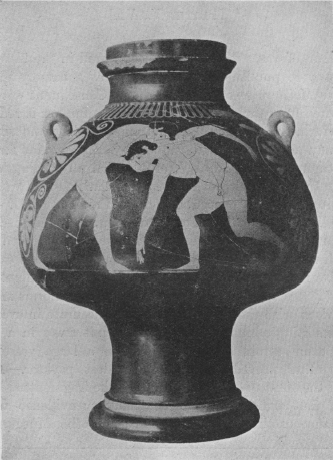No CrossRef data available.
Article contents
The Bazzichelli Psykter of Euthymides1
Published online by Cambridge University Press: 18 September 2015
Extract
The number of vases which have disappeared in the last twenty years since they first were published is all too large, as a cursory glimpse of the pages of Klein's Meistersignaturen will show. Consequently it is a cause for gratification when from time to time one of their number is rediscovered and finds shelter within the confines of a good museum, its wanderings over. To this list we may add the psykter signed by Euthymides formerly in the collection of Signor Bazzichelli at Viterbo, which after being lost for several years is now in the Archaeological Museum in Turin (Fig. 1).
The credit for its discovery belongs to Professor G. E. Rizzo of the University of Turin, who has with extreme generosity resigned his claims to publication in my favour, and to whom I am greatly indebted for the facts connected with its discovery as well as numerous technical details, a personal examination by me having proved impossible.

Information
- Type
- Research Article
- Information
- Copyright
- Copyright © The Society for the Promotion of Hellenic Studies 1915
References
2 Originally published by Klügmann, , Ann. d. Inst. 1870, pp. 267–271Google Scholar, Pls. O, P. The drawings are execrable, and give a very unsatisfactory idea of either the figures or style. Since then quoted by Klein, , Die Griechische Vasen mit Meistersignaturen, p. 196Google Scholar, No. 7; Hoppin, , Euthymides, p. 2Google Scholar, B. It seems probable that Klein's statement (l.c. p. 222), ‘von einem Gefässe dieses Meisters (Euthymides) im Museum zu Turin erhalte ich von J. E. Harrison Mittheilung doch ohne nähere Angabe des Gegenstandes' refers to the psykter, as there is no other vase by Euthymides, or (as far as I know) in his style, in the Turin collection.
3 Though the r. forearm of the l.h. youth is missing, there can be little doubt as to the action.
4 Cat. des Vases du Louvre, iii. p. 696.
5 L.c. p. 269. Furtwängler's suggestion for the senseless formula ειδονθεμεν on Munich 410 (‘εἱδον : θέωμεν’) might be considered in line with this. v. F.R. i. p. 176.
6 While I do not wish to discuss here the question of καλός names, it is certainly striking that so many of them—Megakles, Hipparchos, Leagros, and Phayllos—to mention only a few, should coincide so patly with prominent figures of Athens and at this time ‘men about town.’ I see no reason why we should not recognise here a reference to Olympiodoros, son of Lampon and probably father of Lampon, co-founder of Thurii (Thuc. v. 19, 24), soothsayer and friend of Perikles. This Olympiodoros, as Herodotos tells us (ix. 21), with three hundred Athenian troops defended a dangerous corner at the outpost of Erythrae just before the battle of Plataea, in the course of which skirmish Masistios was slain (cf. Busolt, Griech. Ges. ii. p. 727). The date of our vase certainly coincides with the youth of Olympiodoros if he was a general at Plataea.
7 Can it be possible that the proprietor of the atelier was Hauser's ‘Frau Meisterin’ and Euthymides, her workman and swain, wrote the name of his lady-love by mistake?
8 Since Euthymides uses the καλός name of Phayllos and it is generally agreed that this refers to the celebrated athlete of Croton who commanded a ship at Salamis, it is obvious, as Furtwängler has pointed out (F.R. ii. p. 111), that it will not do to separate the activity of Euthymides too far from the year of that event. On the other hand it is unsafe to place him too far away from the Epiktetan cycle in which he certainly worked.

